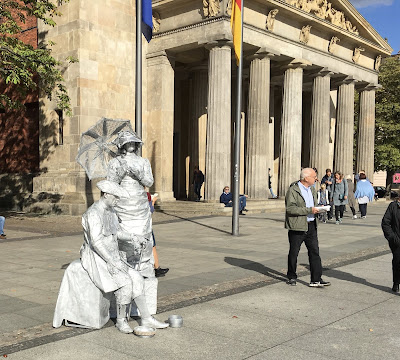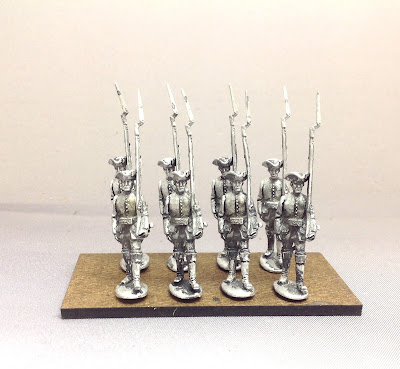 |
| Colonel's (left) and Regimental (right) colours of the 3rd Regiment of Observation Corps Musketeers, shown with Minden standard bearers for the Observation Corps. |
Click on all pix to enlarge
Yesterday I made my own flags for the 3rd Regiment of the Russian Observation Corps Musketeers using the flag images that are available on the Kronoskaf web site. If you are unfamiliar with Kronoskaf and you have an interest in the Seven Years War, then you owe it to yourself to click on the link below and visit the site.
The link takes you to the home page of the site. Click on the link called "Armies" and then select from the list of countries that are available for articles. In this case, click on "Russia" which will take you to the page of articles on the Russian army of the SYW. There is a list of combat arms such as cavalry, artillery and ordanance, infantry (with subcategories for musketeers, grenadiers, Observation Corps, light troops, etc.).
The Observation Corps flags can be found Here
 |
| Regimental flag of the 3rd Regiment Observation Corps Musketeers. (Kronoskaf flag image) |
I have had some success taking the basic flag image, creating a two-sided flag, and then embellishing the flag with hand-painting the emblems and designs on the flag. The end result is a hand-painted flag that looks very nice. I have posted the original Kronoskaf flags on this thread so that you can compare them to the ones that I hand-painted.
 |
| Reverse side of the Observation Corps colours. |
The process is as follows:
- click on the flag image and download the image to your computer. I use an Apple system so my procedures apply to the Apple world, but I would imagine that Windows based systems use similar procedures.
- open up you Downloads file and select the desired flag image that you want to customize
- click on the image and using your cursor, outline the flag but cut off the flag pole and finial part of the image.
- click on the Tools drop down menu and select "crop".
- save the edited image under a new file name.
- Open up a new Word document and insert the new flag image in the document.
- click on the flag image - there will be a sort of arrow in each corner of the flag, use your cursor to click on one of these and use to resize the flag to a serviceable size. I find that 1.5" square or slightly larger is a good size for each side of the flag.
- once you have sized the flag, then click on the flag agains and select "Copy" from the Edit drop down menu.
- clikc your cursor next to the flag image in your Word document and select "Paste". You will now have both sides of the flag next to each other, creating a two-sided flag.
- Now you can print off your flag on a color printer
Once the flag is printed, then cut out the flag and double check to make sure that the size of the flag fits with your miniature standard bearer figure.
- glue the flag to the flag pole with white glue (I use the "Elmers" brand of school glue). I spread the glue across the paper using a tool called a "clay shaper" which you can buy at a craft store such as Michael's or Joanna Fabrics. It has a paint brush style handle with a synthetic rubber tip - use one of the tools that has a flat edge. Using this tool, you don't have the problem of glue drying on a paint brush after you are finished using it because the glue wipes right off with a piece of tissue or even your finger tipe.
- press the halves of the flag together and use a small paint brush handle or a pencil to shape furls into the flag. Note that flags tend to flap and furl on the downward diagonal axis away from the flag pole. Many gamers tend to use a furl that is parallel to the staff. Don't do this - it is unrealistic and does not look as good as a flag that is furled on the diagonal axis.
Now you are ready to paint the surface of nearly the entire flag image.
- start with the "field" of the flag and paint the surface with an acrylic paint color that is similar to the color on the printed image. In the case of my Observation Corps flags, I used a P3 brand green paint called "Knarls Green" as my basic shade color. Paint all green areas green, but leave a very slight amount of green near the flag emblems unpainted and let the original color show through. Later in the process I will add highlights to the colors on the flags.
- All of the cloud designs on the flag are painted over with a light grey paint (IWM brand "Light Grey" or a similar craft paint was used on my flag).
- The black double headed eagle is next. I take some basic black paint and mix in some white paint until I get a dark grey/light black color. I paint strokes of the dark grey on the feathers to add a dimension/depth to the eagle. Later, I will go back and mix up a slightly lighter version of the dark grey and paint some highlight strokes on the wings to really make them "pop" and get noticed.
- Red areas are painted with a Reaper brand "Blood Red" color and then highlighter with Reaper "Bright Red". If you want even more depth to the red, add a second highlight (your third variety of red) of "Fire Red" Reaper paint to the red bits.
- Now to the gold sunburst image that is behind the eagle. I paint the whole sunburst P3 "Rucksack Tan" as the base shade color. Next I paint strokes of P3 "Mouldy Ochre" color to highlight the basic rays of the sunburst. Finally, I mix some white paint into the Mouldy Ochre paint to create a highlight color and carefully add strokes of this color over the Rucksack Tan strokes. Be sure to leave some of the shade color on the edges of the highlight brush strokes. I wasn't entirely satisfied with the highlighting of the yellow bits, so I took some Reaper Master Series "Candlelight Yellow - 09408" and put dabs of this color on the tips of the sunburst rays.
- Next I outline the yellow bits on the edges of the central emblem of the flag. I think that it is St. George, but I'm not sure and it doesn't really matter. The lines are so tiny that I only used the P3 Mouldy Ochre paint color and did not bother with shades or highlights for the lines. There are some white bits on St. George so I dabbed some white paint on these but tried not to touch up the tiny St. George image too much because sometimes too much is "too much" in appearance.
- Now I work on the flames that are in each corner of the flag. These are red on the regimental flag. I paint the whole flame Reaper Blood Red and then add the Bright Red and Fire Red highlights to the flames.
- Time to paint highlights onto the green field of the flag, using Reaper "Leaf Green" color, paint brushstrokes of the colors on every bit of the flag that is where you would expect to see lighter colors such as the top part of the furl. The recessed portions of the furl are left untouched (i.e. in Gnarls Green). Now if you are really confident in your highlighting skills, then add some white paint to the Leaf Green paint color to create an even lighter highlight and add a few brushstrokes of this mix to the raised areas of the flag which you have already painted Leaf Green. Use this second highlight color sparingly.
That completes the repainting of the regimental flag for the 3rd Regiment of Observation Corps Musketeers. The colonel's white color is done in a similar manner on the emblems and designs of the flag. For the field, I often leave the field in the white color from the printed image, but add a few brushstrokes of light grey here and there to some of the folds and creases of the flag where you would expect to shade the white. Use the grey sparingly. I few lines are all that you need. Again, too much will overwhelm the visual impact.
 |
| Colonel's Colour - 3rd Regt. Observation Corps Musketeers (Kronoskaf flag image) |
As you can see from the images of my painted flags, you have basically hand-painted your own flag. All that you have done is paint over the printed image with your own acrylic paint. The effort takes about 1 to 2 hours per flag, but I think that it is well worth the time spent.
zz












































